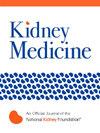维持性透析启动预测工具的开发:来自静冈Kokuho数据库研究的589,284名参与者的回顾性队列分析
IF 3.4
Q1 UROLOGY & NEPHROLOGY
引用次数: 0
摘要
理由与目的早期慢性肾脏疾病(CKD)很少开始维持性透析,这使得准确的风险分层变得困难。我们试图建立一个基于常规健康检查数据的简单预测评分。研究设计回顾性队列研究。背景和参与者:2012-2020年,日本静冈县参加政府规定的健康检查的成年人(≥40岁)(N = 589,284)。预测指标基线人口统计、生命体征、实验室指标、药物使用和生活方式因素在健康检查中常规记录。结果从第一次健康检查到开始维持性透析的时间,由程序规范确定;死亡被视为一种竞争风险。三分之二的参与者被随机分配到训练队列(n = 392,856;事件= 335),三分之一的参与者被分配到测试队列(n = 196,428;事件= 179)。病因特异性Cox模型生成的风险比转换为整数分数(最大31分)。用Harrell’s c-index评价辨别力,用累积发生率曲线进行校准。在中位5.9年的随访期间,514名参与者(0.09%)开始透析。独立预测因素包括男性、体重指数18.5 kg/m2、较高的收缩压、血红蛋白A1c≥8%、较低的肾小球滤过率、蛋白尿、天冬氨酸转氨酶≥50 IU/L、使用降压或降糖药物以及习惯性吸烟。该评分在训练队列(c-index, 0.916; 95%可信区间[CI], 0.898-0.934)和检验队列(c-index, 0.916; 95% CI, 0.889-0.943)中均表现出极好的判别性。高危人群(评分≥16分,占队列的0.3%)5年透析发生率为4.6%,但95%仍未透析,这凸显了预测这一罕见结果的挑战。局限性:sckd发病时间早于队列研究,处方数据未分析因果关系,外部验证尚待验证。结论:sour模型利用常规健康检查数据,准确识别出未来透析风险较高的人群,尽管事件发生率较低。许多早期肾脏问题不为人注意,直到突然需要透析。我们想知道日本每年已经收集的常规健康检查数据是否可以更快地向临床医生发出警告。我们跟踪了一大批定期体检的成年人,记录了一些简单的指标,如体重、血压、血糖、尿蛋白、肾脏滤过率、吸烟状况和常用处方。使用这些项目,我们建立了一个简单的分数,将人们分为低、中、高风险,以后需要透析。大多数人仍然避免透析,这表明结果是多么罕见,但得分清楚地突出了那些处于最大危险中的人。将此工具嵌入电子记录中可以促进早期转诊,并有助于保护肾脏健康和福祉。本文章由计算机程序翻译,如有差异,请以英文原文为准。
Development of a Predictive Tool for Maintenance Dialysis Initiation: A Retrospective Cohort Analysis of 589,284 Participants From the Shizuoka Kokuho Database Study
Rationale & Objective
Maintenance dialysis initiation is rare in early-stage chronic kidney disease (CKD), making accurate risk stratification difficult. We sought to build a simple prediction score based on routine health checkup data.
Study Design
Retrospective cohort study.
Setting & Participants
Adults (≥40 years) attending government-mandated health checkups in Shizuoka Prefecture, Japan, 2012-2020 (N = 589,284).
Predictors
Baseline demographics, vital signs, laboratory indices, medication use, and lifestyle factors routinely recorded at health checks.
Outcomes
Time from first health checkup to initiation of maintenance dialysis, ascertained from procedure codes; death treated as a competing risk.
Analytical Approach
Two-thirds of participants were randomly assigned to a training cohort (n = 392,856; events = 335) and one-third to a test cohort (n = 196,428; events = 179). Cause-specific Cox models generated hazard ratios that were converted to integer scores (maximum 31). Discrimination was evaluated with Harrell’s c-index and calibration with performed with cumulative incidence curves.
Results
During a median follow-up of 5.9 years, 514 participants (0.09%) initiated dialysis. Independent predictors included male sex, body mass index <18.5 kg/m2, higher systolic blood pressure, hemoglobin A1c ≥8 %, lower estimated glomerular filtration rate, proteinuria, aspartate aminotransferase ≥50 IU/L, use of antihypertensive or antidiabetic drugs, and habitual smoking. The score showed excellent discrimination in both training (c-index, 0.916; 95% confidence interval [CI], 0.898-0.934) and test (c-index, 0.916; 95% CI, 0.889-0.943) cohorts. High-risk individuals (score ≥16; 0.3% of the cohort) had a 5-year dialysis incidence of 4.6%, yet 95% remained dialysis-free, underscoring the challenge of predicting this rare outcome.
Limitations
CKD onset predated cohort entry, prescription data were not analyzed for causal effects, and external validation is pending.
Conclusions
Our model, leveraging routine health checkup data, accurately identifies persons at elevated risk for future dialysis despite low event rates.
Plain Language Summary
Many early kidney problems go unnoticed until dialysis is suddenly required. We wondered whether the routine health-check data already collected each year in Japan could warn clinicians sooner. We followed a very large group of adults who had regular checkups, recording simple measures such as weight, blood pressure, blood sugar, urinary protein, kidney filtering rate, smoking status, and common prescriptions. Using these items, we built an easy point score that sorts people into low, moderate, or high risk of needing dialysis later on. Most people still avoided dialysis, showing how rare the outcome is, yet the score clearly highlighted those at greatest danger. Embedding this tool in electronic records could prompt earlier referrals and help protect kidney health and wellbeing.
求助全文
通过发布文献求助,成功后即可免费获取论文全文。
去求助

 求助内容:
求助内容: 应助结果提醒方式:
应助结果提醒方式:


